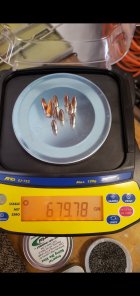Been saving for an A&D FX-120i but with three kids in college it's been a slow process and now my old un-trusty hornady bench scale is going bad so I am out of time and need a new one now. I have it down to three.
Creedmoor Sports TRX-925 (Most affordable, includes calibration weights look to be OIML Class F1)
A&D EJ-123
A&D EJ-54D2
If I order from CE products looks like they give you a calibration weight but it does not mention what class. Nice discount code for the EJ-54D2 making it lower than the EJ-123
All of have good "reviews" but with the creedmoor most of them look to be more of a infomercial than a user review.
Who has used any of the above and happy with it.
Creedmoor Sports TRX-925 (Most affordable, includes calibration weights look to be OIML Class F1)
A&D EJ-123
A&D EJ-54D2
If I order from CE products looks like they give you a calibration weight but it does not mention what class. Nice discount code for the EJ-54D2 making it lower than the EJ-123
All of have good "reviews" but with the creedmoor most of them look to be more of a infomercial than a user review.
Who has used any of the above and happy with it.











